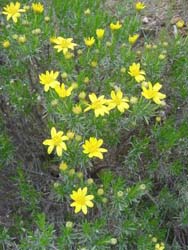Table of Contents
Chaparral
(Larrea tridentata)
- Alias names for Chaparral: Creosote bush, Gobernadora, Greasewood, Hediondilla, Larrea tridentata, Stinkweed
- Chinese Name for Chaparral: None Found
Pictures of Chaparral:
References for Chaparral pictures:
https://articles.grandmasherbs.com/upload/Chaparral-plant-herbal-remedies.jpg (Wow! What a site!)
About Chaparral:
Chaparral is an ancient medicinal plant used by southern Native American tribes. Larrea tridentata grows in the desert regions of the southwestern United States and northern Mexico. Chaparral is a thorny evergreen shrub that has tiny yellow blossoms which turn into white fuzzy seed pods. This shrub, also called the Creosote Bush due to the odor that it expels, grows up to 6 feet tall and 8 feet wide. The leaves and flowers are used for medicinal purposes.
Historical Actions and Uses of Chaparral:
- Acne
- Bronchitis
- Bruises
- Cancer
- Leukemia
- Skin
- Acne
- Cancer
- Eczema
- Rashes
- Aids virus
- Herpes
- Cold sores
- Colds
- Coughing
- Dysmenorrhea
- Dyspepsia
- Gum disease
- Indigestion and heartburn
- Intestinal cramps
- Parasites
- Prolapsed uterus
- Prostate Problems
- Rheumatoid arthritis
- Skin
- Tooth decay
- Tumors
- Urinary infections
- Venereal infections
- Wound healing
How Chaparral is used and how it Works:
Chaparral has lignan, nordihydroguaiaretic acid (NDGA), which is a strong anti-inflammatory. The Chaparral herb also contains antioxidant flavonoids.
- Chaparral lotion as topical treatment for rashes, sores, and wounds.
- Chaparral poultice for respiratory problems
- Chaparral decoction to treat stomach troubles
- Chaparral twigs for toothache
- Chaparral wash/spa/bath to/for detoxify, skin problems, skin parasites
- Chaparral tea for allergies, cramping, joint pain, parasites
- Jason winters tea (but it’s not in there anymore because the FDA made him take it out)
Parts of the Chaparral plant used: Flowers, leaves, and stems
Properties of Chaparral: Antibiotic, anti-inflammatory, anti-amoeba, anti-oxidant, anti-tumor, cancer treatment.
Chemical Constituents of Chaparral: 12% resin and nordihydroguaiaretic acid
Contradictions, safety issues, concerns, harmful drug interactions and allergy precautions for Chaparral: There have been reports of people developing problems with their liver and kidneys. In most cases the people were taking either Chaparral capsules or drinking excessive amounts of Chaparral tea. Some people were reported to have had previous liver disease. It is possible that these could be individual reactions to the herb. The strong taste of Chaparral is disagreeable to most people. This makes it hard to take too much internally before getting nauseous. Capsules should be avoided because they skip the protective taste/nausea mechanism. Do not take internally if you are pregnant, nursing or for more than two weeks at a time unless prescribed by a licensed practitioner. Stop taking Chaparral if swollen glands or urinary difficulties arise. If you have kidney or lymph conditions, avoid the use of Chaparral. Topical use of Chaparral is safe.
Helpful Links and References for Chaparral:
